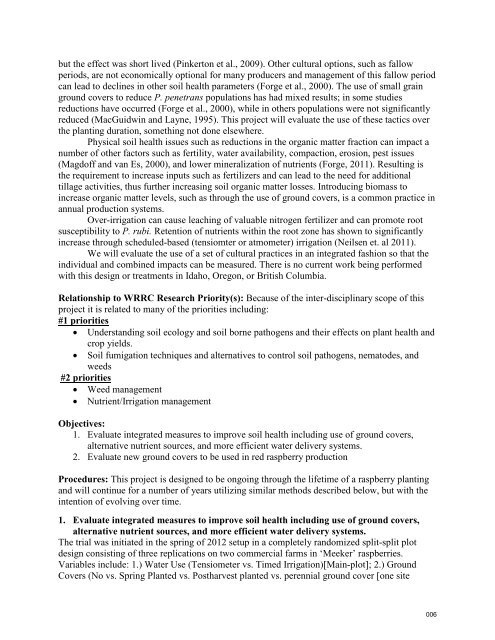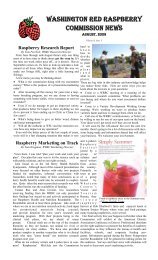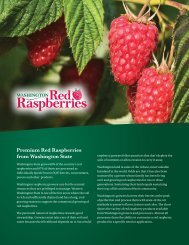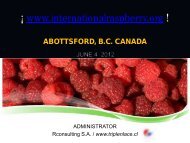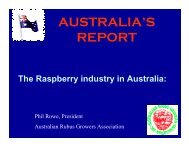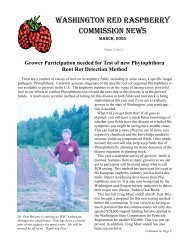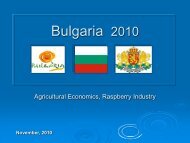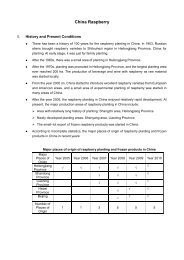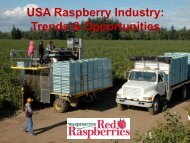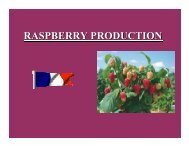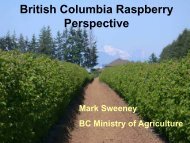2012 - Washington Red Raspberry Commission
2012 - Washington Red Raspberry Commission
2012 - Washington Red Raspberry Commission
You also want an ePaper? Increase the reach of your titles
YUMPU automatically turns print PDFs into web optimized ePapers that Google loves.
ut the effect was short lived (Pinkerton et al., 2009). Other cultural options, such as fallow<br />
periods, are not economically optional for many producers and management of this fallow period<br />
can lead to declines in other soil health parameters (Forge et al., 2000). The use of small grain<br />
ground covers to reduce P. penetrans populations has had mixed results; in some studies<br />
reductions have occurred (Forge et al., 2000), while in others populations were not significantly<br />
reduced (MacGuidwin and Layne, 1995). This project will evaluate the use of these tactics over<br />
the planting duration, something not done elsewhere.<br />
Physical soil health issues such as reductions in the organic matter fraction can impact a<br />
number of other factors such as fertility, water availability, compaction, erosion, pest issues<br />
(Magdoff and van Es, 2000), and lower mineralization of nutrients (Forge, 2011). Resulting is<br />
the requirement to increase inputs such as fertilizers and can lead to the need for additional<br />
tillage activities, thus further increasing soil organic matter losses. Introducing biomass to<br />
increase organic matter levels, such as through the use of ground covers, is a common practice in<br />
annual production systems.<br />
Over-irrigation can cause leaching of valuable nitrogen fertilizer and can promote root<br />
susceptibility to P. rubi. Retention of nutrients within the root zone has shown to significantly<br />
increase through scheduled-based (tensiomter or atmometer) irrigation (Neilsen et. al 2011).<br />
We will evaluate the use of a set of cultural practices in an integrated fashion so that the<br />
individual and combined impacts can be measured. There is no current work being performed<br />
with this design or treatments in Idaho, Oregon, or British Columbia.<br />
Relationship to WRRC Research Priority(s): Because of the inter-disciplinary scope of this<br />
project it is related to many of the priorities including:<br />
#1 priorities<br />
• Understanding soil ecology and soil borne pathogens and their effects on plant health and<br />
crop yields.<br />
• Soil fumigation techniques and alternatives to control soil pathogens, nematodes, and<br />
weeds<br />
#2 priorities<br />
• Weed management<br />
• Nutrient/Irrigation management<br />
Objectives:<br />
1. Evaluate integrated measures to improve soil health including use of ground covers,<br />
alternative nutrient sources, and more efficient water delivery systems.<br />
2. Evaluate new ground covers to be used in red raspberry production<br />
Procedures: This project is designed to be ongoing through the lifetime of a raspberry planting<br />
and will continue for a number of years utilizing similar methods described below, but with the<br />
intention of evolving over time.<br />
1. Evaluate integrated measures to improve soil health including use of ground covers,<br />
alternative nutrient sources, and more efficient water delivery systems.<br />
The trial was initiated in the spring of <strong>2012</strong> setup in a completely randomized split-split plot<br />
design consisting of three replications on two commercial farms in ‘Meeker’ raspberries.<br />
Variables include: 1.) Water Use (Tensiometer vs. Timed Irrigation)[Main-plot]; 2.) Ground<br />
Covers (No vs. Spring Planted vs. Postharvest planted vs. perennial ground cover [one site<br />
006


